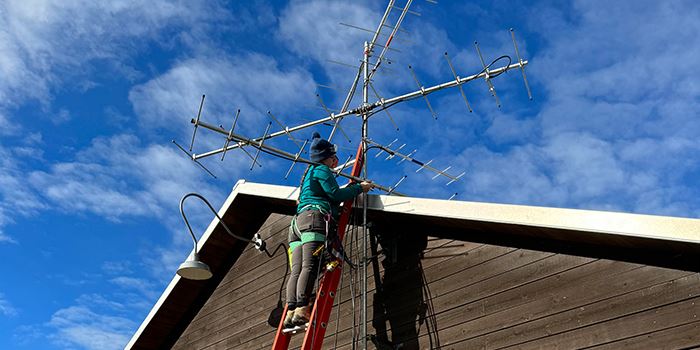Tower Helps Track Species Around the Globe

By Karen Menard
Metroparks Toledo has recently joined an important community of international researchers working together for the conservation of migratory animals. Migrating birds, bats, and insects wearing special, small radio-tracking devices are currently being followed by a network of coordinated receiving stations, called “Motus” towers throughout the world. Locally, one tower now points skyward, placed high atop the Homestead Shelter at Pearson Metropark, installed by Metroparks own conservation science staff alongside researchers from Ohio State University.
This five foot tall metal device with five antennas acts as a data collector, logging information into an international network as it detects each animal flying within 15 km. Tagged with radio-tracking devices placed by researchers across the western hemisphere, these animals are able to be tracked geographically as they travel over the span of many miles. Currently, across 31 countries, there are more than 1,600 coordinated receiving stations (towers), with 2,000 collaborators studying over 300 species.
The “Motus” approach, also known as the Motus Wildlife Tracking System, is hosted by Birds Canada, and reliant on data contributions from partners like Metroparks, and others across the globe. Studies like these that are able to track migration, overall movement patterns, stopover habitat use, and species population dynamics make huge contributions to science and better inform conservation regarding the use of flyways and global landscapes. As birds move north to south and back again, the collaborative efforts of Motus make it easier to fit pieces of the migratory puzzle together by looking at where and when birds have been detected along their journey.
This time of year, winter visitors like snow buntings make their way to our area from the arctic tundra. These beautiful birds can often be seen foraging for weed seeds in open areas like the north wetlands at Pearson Metropark and around the parking lot areas of Howard Marsh. Among other species, snow buntings wearing special tracking devices that pass by the Metropark Motus tower will now be logged into the database, providing additional scientific information about their experiences along their long, migratory journey.
Did You Know?
Snow buntings use snow to clean their feathers which helps unveil their bright white coloration before the spring. The icy snow helps to wear down the earthy brown tips.
For more information on Motus, click the video link below:

For more information on how Motus can be used to track landscape scale movements of snow buntings [Click Here]
---
Photo: (top photo) Ohio State University graduate student Zoe Korpi installs one of the five antennas on Pearson Metropark’s new wildlife tracking tower.